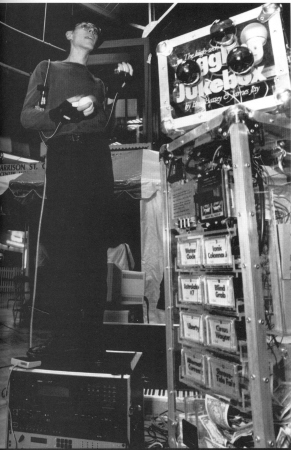
The Juggling Jukebox wires James Jay to a vending machine (Photo by Lincoln McNey) |
Page 25 Spring 1996
|
The
low-tech version omits the bill acceptor. Instead, Jay stands poised
on a milk crate with bowler hat in hand, extended downward. After
receiving a donation, he hands the "user" a business card,
places hat on head, and silently begins to juggle. Once
a viewer makes a selection, the "Jukebox" springs into
action. Jay begins a two-minute choreographed ball-juggling routine
that includes original tricks to delight jugglers and non-jugglers
alike. His favorite trick, (simply because it's completely original)
is the one in the juggling song called "Liberty" in which he
balances a ball on the back of his hand and knocks it off with a throw
from below. As he catches a ball in his palm thrown from below, the
ball balanced on top flies up and off. Then as he catches the ball to
a balance on the top of his hand again, the ball held in his palm
falls out. Jay joked, "I'm trying to 'sell' this trick - forget
that - I'm trying to get a good name for this trick so I can become as
famous as Steve Mills or Rick Rubenstein! My tentative name for it is
'Jay's Knock-off'.''
Jay's
juggling style is at once fluid and mechanical, as flowing human
movement combines with the stiff staccato rhythms of an imagined
machine. His routines are generously peppered with site swaps,
multiplexes and bounce tricks. Even his one ball and two ball routines
are fun to watch. Combinations of mechanically styled movements form
building blocks for juggling tricks the way musical phrases combine to
form songs, literally and figuratively.
The
show has a "cyborgian" aural component as well. Mechanical
sensors attached to Jay's palms and elbows relay electrical signals to
a custom-engineered PAVO MIDl tools box- a small processor that relays
MIDI data to a Macintosh computer. The Macintosh in turn orchestrates
two digital synthesizers that generate musical accompaniment such as
rippling scales, arpeggios and other repeating melodic fragments. A
Macintosh program determines the exact choice and sequence of musical
patterns based on the song the viewer selects and the juggler's
movements.
Jay
explained, "As an example of the computer sensing new phrases,
when I go from the Boston Mess to fake columns (the standard trick
where you carry the third ball in the pattern as a joke), the computer
notices that I'm only catching with one hand, and so it responds with
a musical pattern that underscores that little joke. This is probably
the simplest example of how it works. It gets more complex!
There are all sorts of other electronic communications going on
between the various pieces of equipment, too, but the juggling data is
the most interesting part of the picture. "
Jay's
home page on the World Wide Web includes documentation of the jukebox
with detailed descriptions of the act, photographs, a complete list of
the tricks he performs, technical information, video clips,
performance vignettes, and booking information.
The
Jukebox stands traditional street performing on its head: instead of
performing first and asking for contributions afterward, the jukebox
implicitly asks viewers to pay first, not knowing what they'll get.
Why do they pay? Partly out of curiosity, partly to exert control,
partly to resolve the tension of inaction, and partly to see some
juggling. One wonders who (or what) is really in control: the human
(or is it mechanical) juggler, the computer, or the viewer who sets
the whole contraption in motion by inserting money and selecting a
song? |

The Juggling Jukebox wires James Jay to a vending machine (Photo by Lincoln McNey) |